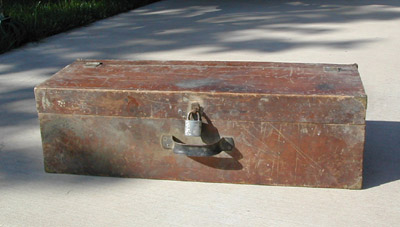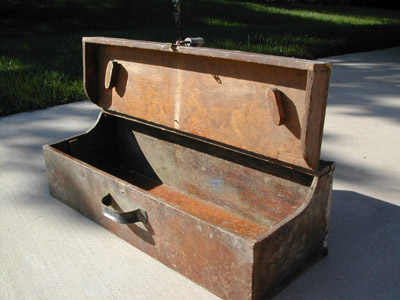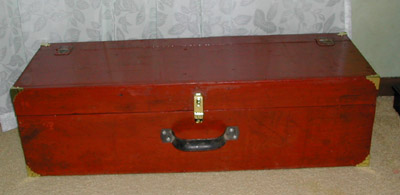
It's just . . . one of those things. Two households full of about 100 years worth of living got combined into one. Stuff got put EVERYWHERE. Memories begin to fail. Lady of the house wants to clear out the junk. Take whatever you want, she tells us. It's going out one way or another.
In the garage is stored the lifetimes of two carpenters. Tools to make any handyman drool, from antique planers that my grandfather collected to the latest Craftsman set. Bits and pieces of unfinished projects. Billions of nails. Discarded furniture. A dollhouse I want to finish, mainly for the sake of needing to finish it.
So I'm poking about in there one day and spy a long wooden box under the workbench. I pull it out, hesitantly, as goodness knows what or who is in it. It's obviously a toolbox, but all the other toolboxes in the garage are made out of metal. Half of them are rusted.

"That belonged to either your grandfather, your great grandfather, or your great great grandfather," my grandmother tells me. She can't remember whose it was, or who made it. We discuss the possibilities of its original owner, and the anecdote about the way my grandfather always inscribed his belongings with his devil face logo. (although I always thought it was a fox.) There's no such markings on this box. No markings at all. Well, that's not exactly true. There's pencil marks, and scratches, and cuts, and divots, and drips and burns, and rust. "Take it home!" Grammy urges. I like it. I don't know why, except it's a cool old wood box. It looks about right for storing magazines, which would be an improvement from the popcorn tins I was using.

So, the box comes home with me, and I give it a good examination. There's a Yale lock on it, but someone had unscrewed the metal latch that held it to the box. It was obviously made out of scrap wood, but a lot of thought had gone into designing it. All its edges meet snugly. There are metal corners protecting each corner, and some are thicker than others. The box was designed to sit with the handle in the air. Inside, I find two strange knobs of wood and a thick metal hook. I guessed that the hook was for holding a hammer or some other heavy tool in place, but the knobs of wood confuse me for a long time. Upon peering closer at the lid of the box, I see pencil marks tracing out the odd shape of the wood, and then I notice a long indented line running crisscross . . . wheels turn. It's meant to hold two hand saws! I was pleased with the cleverness of it. However, the metal hook had to come out, and the lock had to come off. The hook gave me no problems, but I had to apply Dad and a bolt cutter to the lock. It was in the way! Then, it got a good cleaning.
The restoration was quite easy. I had a can of wood stain left over from my desk. I didn't WANT it to be spotless and pristine and smooth. It was a toolbox, and at times, a workbench. I wanted that history to show. I was most worried about replacing the metal corners and the latch, which were all rusty, but that proved to be an easy task. I found the exact same corners and latch at Lowes. I wondered if this was just a timeless type of thing made by companies for generations, or if the corners had been replaced in the past 10 to 15 years.

I remain amazed at the beauty of the finished project. The thing GLOWS proudly, with no varnish, showing its scars and age with dignity. It holds a shocking amount of books and magazines. I find myself using it as a workbench for my miniatures, although I try to avoid doing so. Perhaps it wants me to store my tools in it after all?
